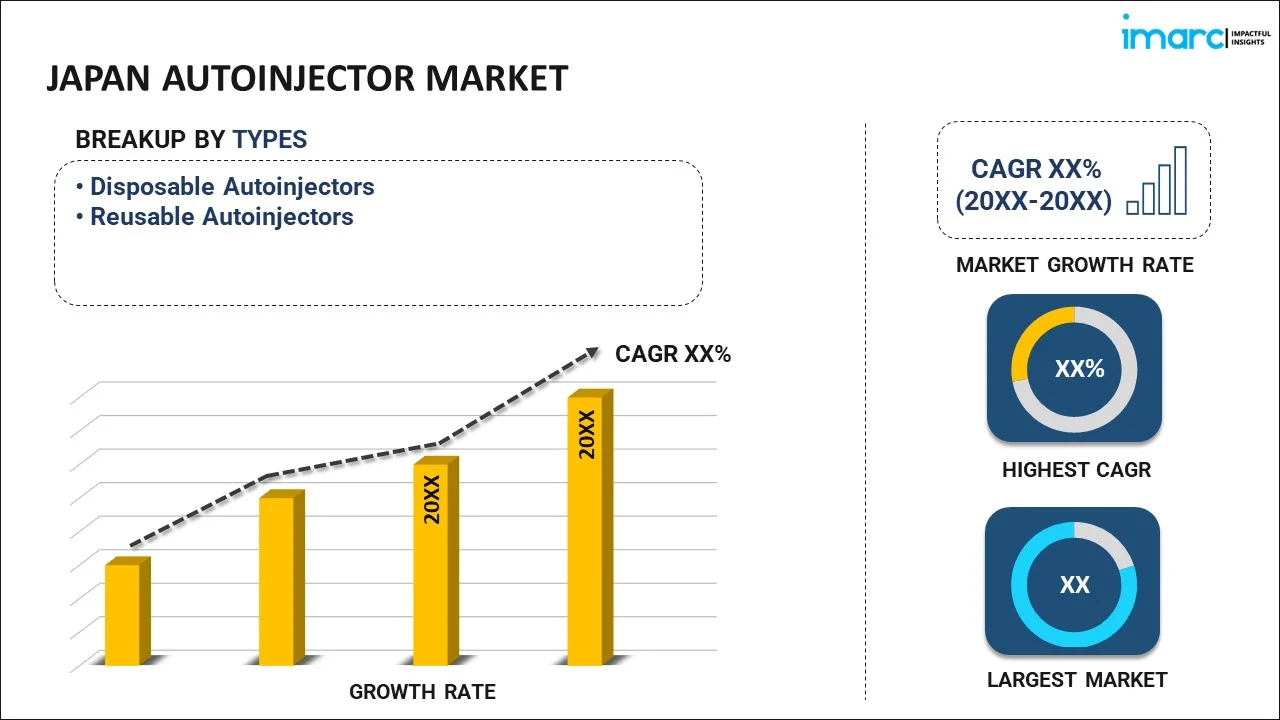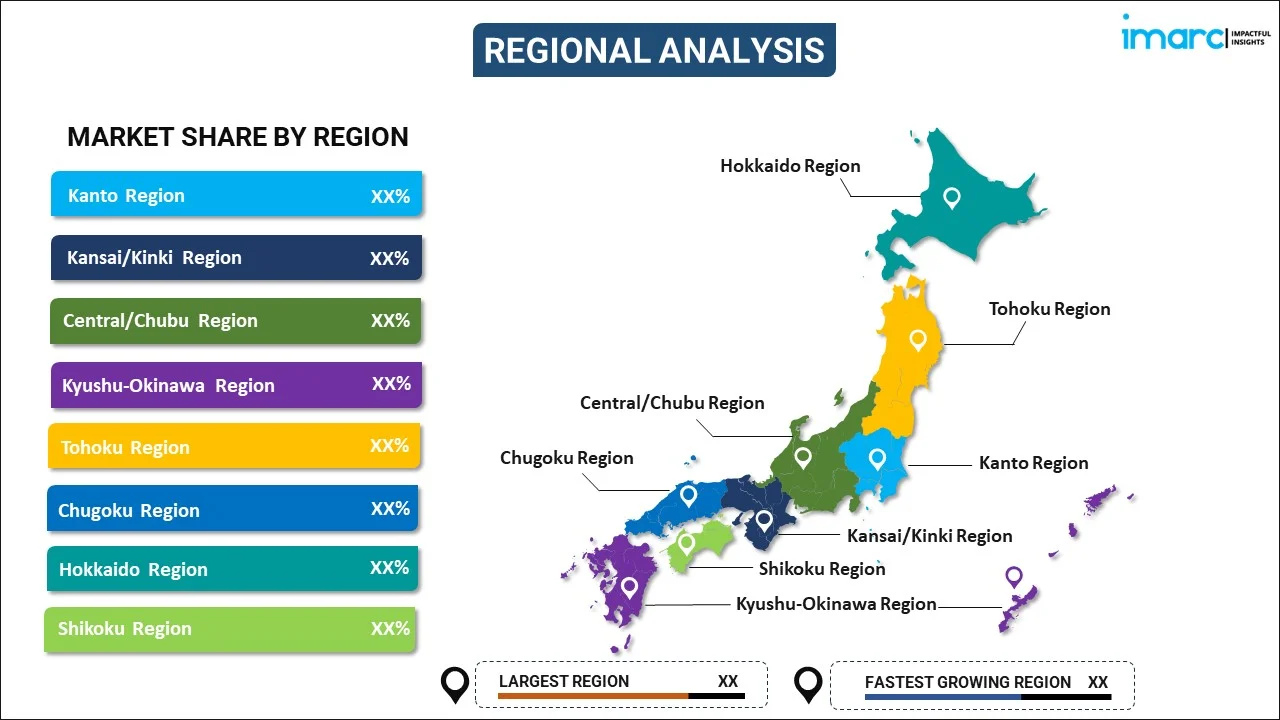
Japan Autoinjector Market Report by Type (Disposable Autoinjectors, Reusable Autoinjectors), Application (Rheumatoid Arthritis, Anaphylaxis, Multiple Sclerosis, and Others), End User (Home Care Settings, Hospitals and Clinics), and Region 2025-2033
Market Overview:
Japan autoinjector market size reached USD 93.6 Million in 2024. Looking forward, IMARC Group expects the market to reach USD 393.5 Million by 2033, exhibiting a growth rate (CAGR) of 16.3% during 2025-2033. Numerous advancements in the healthcare industry, regulatory approvals by government bodies, and the inflating popularity of using user-friendly drug delivery systems represent some of the key factors driving the market growth across the country.
|
Report Attribute
|
Key Statistics
|
|---|---|
|
Base Year
|
2024 |
|
Forecast Years
|
2025-2033
|
|
Historical Years
|
2019-2024
|
| Market Size in 2024 | USD 93.6 Million |
| Market Forecast in 2033 | USD 393.5 Million |
| Market Growth Rate (2025-2033) | 16.3% |
Autoinjector are devices designed for self-administration of drugs through subcutaneous or intramuscular routes. They provide numerous benefits, including precise dosage delivery, enhanced patient adherence, and the mitigation of needle-related anxieties. These devices effectively address needle phobia, reduce the risk of needlestick injuries due to concealed needles, and streamline the healthcare process for professionals. Autoinjectors play a crucial role in emergency situations like anaphylaxis, migraines, status epilepticus, psoriasis, diabetes, multiple sclerosis, and rheumatoid arthritis. Consequently, their widespread use is observed in various healthcare settings, encompassing hospitals, clinics, and home care centers throughout Japan. The versatility and efficiency of autoinjectors contribute significantly to improving medical outcomes while providing a more accessible and user-friendly approach to drug administration in diverse medical conditions.
Japan Autoinjector Market Trends:
The Japan autoinjector market is propelled by a convergence of numerous healthcare advancements and local trends. Additionally, the aging population and increasing prevalence of chronic diseases in the country drive the demand for user-friendly drug delivery systems like autoinjectors, which is acting as significant growth-inducing factor. Moreover, these devices offer a solution for self-administration, catering to the growing emphasis on home-based healthcare and patient empowerment. Besides this, the rising awareness among individuals towards anaphylaxis, migraines, diabetes, and autoimmune disorders further fuels the adoption of autoinjectors. Furthermore, technological innovations, such as smart autoinjectors with connectivity features, exemplify Japan's commitment to cutting-edge healthcare solutions. Collaborations between pharmaceutical companies and device manufacturers result in enhanced product designs and usability. In line with this, sustainability is emerging as a notable trend, with a focus on eco-friendly materials and production processes, which is also catalyzing the market growth across the country. As Japan continues to navigate its evolving healthcare landscape, it will reflect a harmonious blend of numerous advancements and culturally specific healthcare needs, contributing to the nation's commitment to accessible and efficient healthcare solutions. This, in turn, is expected to fuel the market growth over the forecasted period.
Japan Autoinjector Market Segmentation:
IMARC Group provides an analysis of the key trends in each segment of the market, along with forecasts at the country level for 2025-2033. Our report has categorized the market based on type, application, and end user.
Type Insights:

- Disposable Autoinjectors
- Reusable Autoinjectors
The report has provided a detailed breakup and analysis of the market based on the type. This includes disposable autoinjectors and reusable autoinjectors.
Application Insights:
- Rheumatoid Arthritis
- Anaphylaxis
- Multiple Sclerosis
- Others
A detailed breakup and analysis of the market based on the application have also been provided in the report. This includes rheumatoid arthritis, anaphylaxis, multiple sclerosis, and others.
End User Insights:
- Home Care Settings
- Hospitals and Clinics
The report has provided a detailed breakup and analysis of the market based on the end user. This includes home care settings and hospitals and clinics.
Regional Insights:

- Kanto Region
- Kansai/Kinki Region
- Central/ Chubu Region
- Kyushu-Okinawa Region
- Tohoku Region
- Chugoku Region
- Hokkaido Region
- Shikoku Region
The report has also provided a comprehensive analysis of all the major regional markets, which include Kanto Region, Kansai/Kinki Region, Central/ Chubu Region, Kyushu-Okinawa Region, Tohoku Region, Chugoku Region, Hokkaido Region, and Shikoku Region.
Competitive Landscape:
The market research report has also provided a comprehensive analysis of the competitive landscape in the market. Competitive analysis such as market structure, key player positioning, top winning strategies, competitive dashboard, and company evaluation quadrant has been covered in the report. Also, detailed profiles of all major companies have been provided.
Japan Autoinjector Market Report Coverage:
| Report Features | Details |
|---|---|
| Base Year of the Analysis | 2024 |
| Historical Period | 2019-2024 |
| Forecast Period | 2025-2033 |
| Units | Million USD |
| Scope of the Report | Exploration of Historical and Forecast Trends, Industry Catalysts and Challenges, Segment-Wise Historical and Predictive Market Assessment:
|
| Types Covered | Disposable Autoinjectors, Reusable Autoinjectors |
| Applications Covered | Rheumatoid Arthritis, Anaphylaxis, Multiple Sclerosis, Others |
| End Users Covered | Home Care Settings, Hospitals and Clinics |
| Regions Covered | Kanto Region, Kansai/Kinki Region, Central/ Chubu Region, Kyushu-Okinawa Region, Tohoku Region, Chugoku Region, Hokkaido Region, Shikoku Region |
| Customization Scope | 10% Free Customization |
| Post-Sale Analyst Support | 10-12 Weeks |
| Delivery Format | PDF and Excel through Email (We can also provide the editable version of the report in PPT/Word format on special request) |
Key Questions Answered in This Report:
- How has the Japan autoinjector market performed so far and how will it perform in the coming years?
- What has been the impact of COVID-19 on the Japan autoinjector market?
- What is the breakup of the Japan autoinjector market on the basis of type?
- What is the breakup of the Japan autoinjector market on the basis of application?
- What is the breakup of the Japan autoinjector market on the basis of end user?
- What are the various stages in the value chain of the Japan autoinjector market?
- What are the key driving factors and challenges in the Japan autoinjector?
- What is the structure of the Japan autoinjector market and who are the key players?
- What is the degree of competition in the Japan autoinjector market?
Key Benefits for Stakeholders:
- IMARC’s industry report offers a comprehensive quantitative analysis of various market segments, historical and current market trends, market forecasts, and dynamics of the Japan autoinjector market from 2019-2033.
- The research report provides the latest information on the market drivers, challenges, and opportunities in the Japan autoinjector market.
- Porter's five forces analysis assist stakeholders in assessing the impact of new entrants, competitive rivalry, supplier power, buyer power, and the threat of substitution. It helps stakeholders to analyze the level of competition within the Japan autoinjector industry and its attractiveness.
- Competitive landscape allows stakeholders to understand their competitive environment and provides an insight into the current positions of key players in the market.
Need more help?
- Speak to our experienced analysts for insights on the current market scenarios.
- Include additional segments and countries to customize the report as per your requirement.
- Gain an unparalleled competitive advantage in your domain by understanding how to utilize the report and positively impacting your operations and revenue.
- For further assistance, please connect with our analysts.
 Inquire Before Buying
Inquire Before Buying
 Speak to an Analyst
Speak to an Analyst
 Request Brochure
Request Brochure
 Request Customization
Request Customization




.webp)




.webp)












